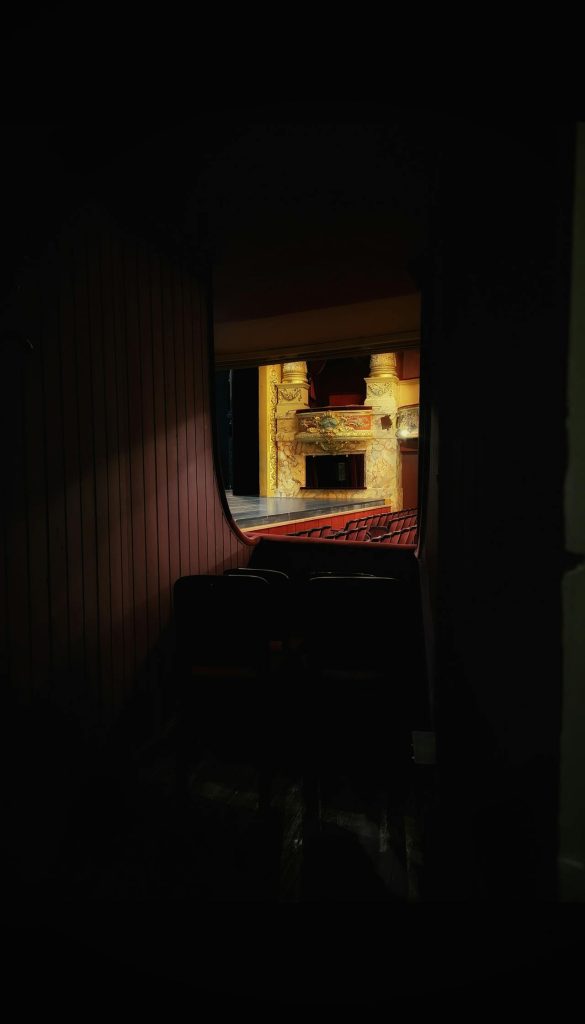Table of Contents
Theatre Décor Art: A Symbiosis of Visual Design and Performance
Theatre has long been regarded as a multifaceted art form that combines literature, performance, music, and visual arts. Among these elements, theatre décor—encompassing set design, stage architecture, and visual aesthetics—plays a vital role in shaping the overall experience of a performance. Far from being a mere backdrop, theatre décor is a dynamic participant in storytelling, transforming space, mood, and meaning. This essay explores the evolution, techniques, and artistic significance of theatre décor, illustrating its profound impact on the theatrical experience.

Photo By Pexels
1. The Historical Evolution of Theatre Décor
The history of theatre décor art is as rich and varied as the art of theatre itself, tracing back to the ritualistic performances of ancient civilizations. In ancient Greece, theatre décor was relatively minimalistic. The primary focus was on the actors and the chorus, with basic skene (scene) structures providing a backdrop that suggested temples or palaces. The Romans, by contrast, introduced more elaborate and realistic set designs, influenced by their mastery in architecture and engineering.
During the medieval period, theatre décor became more sophisticated through the use of mansions—small scenic structures that represented different locations and could be used for religious plays. The Renaissance brought a transformative era for theatre décor as perspective drawing and developments in scenic art flourished. Innovators such as Sebastiano Serlio and Nicola Sabbatini incorporated mathematical precision into stage design, introducing movable scenery and creating illusions of depth. Baroque theatre, especially in Italy, saw the birth of extravagant stage machinery and opulent décor, emphasizing grandeur and spectacle.
By the 19th and 20th centuries, theatre décor evolved alongside new theatrical movements. The advent of realism prompted set designers to create environments with meticulous attention to detail, while the symbolist and expressionist movements used décor to evoke psychological states and symbolic meaning. Modern and contemporary theatre has since embraced minimalism, interactive design, and technological integration, exploring how décor interacts not only with performers but also with the audience.
2. The Craftsmanship Behind Theatre Décor
Creating theatre décor is an interdisciplinary art that brings together visual artists, architects, engineers, and dramaturges. It requires an understanding of aesthetics, narrative flow, and practical construction. The primary purpose of set design is not only to reflect the setting but to enhance the narrative and subtext of the play, aligning visual elements with thematic content.
Materials and Techniques:
Early theatre relied on wood, cloth, and painted backdrops. As technology advanced, the use of more durable and versatile materials, such as metal and acrylics, became commonplace. Techniques such as trompe-l’œil (a visual illusion in art) were employed to trick the eye into perceiving a three-dimensional scene on a two-dimensional surface.
Lighting and Color Schemes:
An essential part of theatre décor art is the use of lighting. Stage lighting has evolved from rudimentary oil lamps and candles to sophisticated LED and computer-controlled lighting systems. Lighting can transform a simple set into an immersive experience, directing the audience’s attention, conveying time and mood, and complementing the narrative. The interplay between light and color schemes within set design often carries emotional weight, contributing to the storytelling without words. For instance, a stark, monochrome set bathed in cold blue light might evoke desolation, while a vibrant, colorful set under warm, golden light might evoke joy or nostalgia.
Integration of Multimedia:
Modern theatre décor often integrates multimedia elements, such as projections, holograms, and digital scenery. This convergence of technology with traditional set design offers new dimensions to productions, allowing sets to shift and change dynamically. Productions such as The Curious Incident of the Dog in the Night-Time exemplify this trend, where digital mapping and projections were used to represent the protagonist’s inner world.
3. Artistic and Philosophical Significance
Theatre décor art extends beyond the decorative; it encapsulates the vision of the playwright and director, translating abstract ideas into tangible form. Décor can set the tone, define space, and interact with characters in a way that deepens the narrative. A well-designed set can become a character in its own right, embodying themes or becoming a silent witness to the action.
For instance, in Ibsen’s A Doll’s House, the meticulously arranged, confined space of the Helmer living room underscores the themes of domestic entrapment and societal norms. In Beckett’s Waiting for Godot, the sparse, almost barren stage becomes a visual metaphor for existential emptiness. Similarly, Brecht’s epic theatre famously utilized set design as a tool for Verfremdungseffekt (alienation effect), preventing audiences from becoming emotionally absorbed in the narrative and instead encouraging them to think critically about the play’s themes.
4. Challenges and Future Directions
While theatre décor art has flourished, it faces several challenges in the contemporary world. Budget constraints often limit the scope of design, pushing set designers to be innovative with fewer resources. Moreover, the rise of digital platforms and virtual reality brings new questions to the forefront: how will live performance adapt as audiences become increasingly accustomed to digitally enhanced experiences?
The future of theatre décor lies in the balance between tradition and innovation. Sustainable design practices are emerging, with set designers focusing on eco-friendly materials and reusable sets. The incorporation of artificial intelligence and augmented reality promises to further transform how theatre décor interacts with audiences and actors alike, making the stage not just a place of performance, but a participatory, immersive environment.
Conclusion
The art of theatre décor transcends mere aesthetics; it is an intricate, thoughtful craft that weaves visual storytelling into the fabric of performance. From the grandiose sets of the Baroque period to the minimalist and technologically enhanced designs of the present day, theatre décor continues to be a vital, evolving aspect of theatrical art. It embodies the union of art, architecture, and drama, enriching the audience’s experience and providing a deeper understanding of the narrative. In its ability to shape perception, evoke emotion, and enhance the narrative, theatre décor affirms its place as an indispensable element of the theatrical tradition.


No responses yet